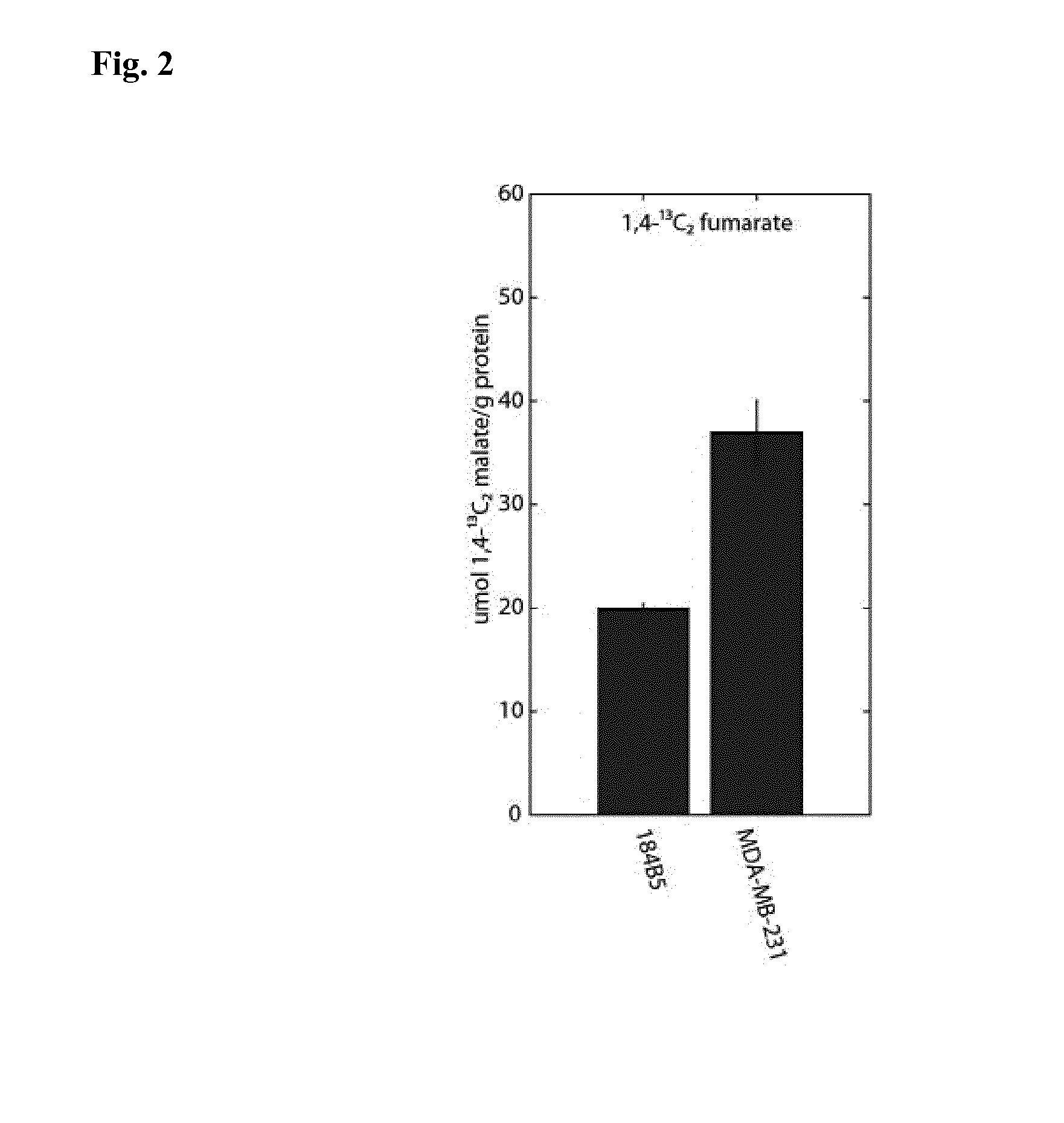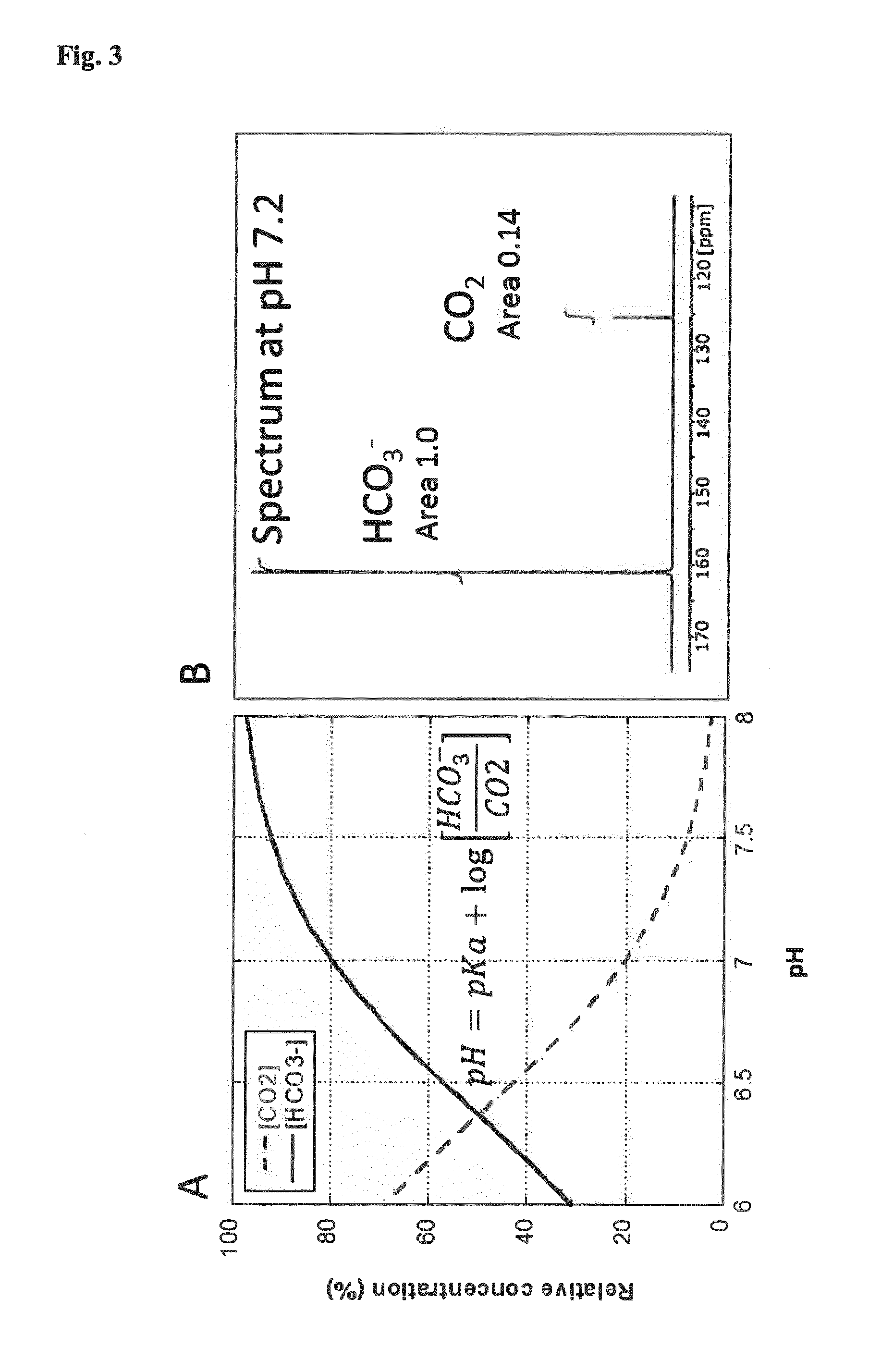Intra-Operative Cancer Diagnosis Based on a Hyperpolarized Marker
a marker and intraoperative technology, applied in the field of intraoperative cancer diagnosis based on hyperpolarized markers, can solve the problems of invasion and metastasis, low likelihood of cancer spreading, and low specificity of the above-described preliminary histological investigation,
- Summary
- Abstract
- Description
- Claims
- Application Information
AI Technical Summary
Benefits of technology
Problems solved by technology
Method used
Image
Examples
example 1
3.1. Example 1
Detecting Cancer Metastases in Sentinel Lymph Nodes Through Differentiated Uptake of 15N Choline
[0243]Step 1: a sample of 15N choline, 0.05 mmol, is hyperpolarized according to procedures known in the art (Allouche-Arnon et al. Contrast Media Mol Imaging. 2011 November-December; 6(6):499-506).
[0244]Step 2: a sentinel lymph node from a prostate cancer patient undergoing prostate cancer surgery for a primary tumor in the prostate is identified, excised and rapidly (preferably within one minute from completed excision) placed in a 4 ml vessel filled with Ringer's solution tempered to 37° C.
[0245]Step 3: the vessel containing the lymph node is placed in an MR scanner which has been tuned to 15N and shimmed on a phantom resembling the vessel with the lymph node.
[0246]Step 4: the hyperpolarized marker is dissolved in 5 ml phosphate buffer (40 mM, pH 7.3) and otherwise prepared for use according to procedures known in the art (Ardenkjaer-Larsen et al. Proc Natl Acad Sci USA. ...
example 2
3.2. Example 2
Detecting Cancer Metastases in Sentinel Lymph Nodes Through Differentiated Uptake of 1-13C Acetate
[0251]Step 1: a sample of 1-13C acetate, 0.05 mmol, is hyperpolarized according to procedures known in the art (Jensen et al. J Biol Chem. 2009 Dec. 25; 284(52):36077-82).
[0252]Step 2: a sentinel lymph node from a breast cancer patient undergoing breast cancer surgery for a primary tumor in the breast is identified, excised and rapidly (preferably within one minute from completed excision) placed in a 2 ml vessel filled with Ringer's solution tempered to 37° C.
[0253]Step 3: the vessel containing the lymph node is placed in an MR scanner which has been tuned to 13C and shimmed on a phantom resembling the vessel with the lymph node.
[0254]Step 4: the hyperpolarized marker is dissolved in 5 ml phosphate buffer (40 mM, pH 7.3) and otherwise prepared for use according to procedures known in the art (Ardenkjaer-Larsen et al. Proc Natl Acad Sci USA. 2003 Sep. 2; 100(18):10158-63)....
example 3
3.3. Example 3
Detecting Cancer Metastases in Sentinel Lymph Nodes Through pH Differences
[0259]Step 1: a sample of 13C bicarbonate, 0.1 mmol, is hyperpolarized according to procedures known in the art (Gallagher et al. Nature. 2008 Jun. 12; 453(7197):940-3).
[0260]Step 2: a sentinel lymph node from a colon cancer patient undergoing colon cancer surgery for a primary tumor in the colon is identified, excised and rapidly (preferably within one minute from completed excision) placed in a 1 ml vessel filled with Ringer's solution tempered to 37° C.
[0261]Steps 3 to 4 are performed as in example 2.
[0262]Step 5: a fraction of the solution, 25 μl, containing the hyperpolarized marker is injected into the lymph node.
[0263]Step 6: after 10 to 30 s, a 13C MR spectroscopic investigation is performed on the lymph node and the signals from 13C bicarbonate and 13C carbon dioxide are quantified. The pH is calculated according to the Henderson-Hasselbalch equation (see FIG. 3) and compared to a standa...
PUM
 Login to View More
Login to View More Abstract
Description
Claims
Application Information
 Login to View More
Login to View More - R&D
- Intellectual Property
- Life Sciences
- Materials
- Tech Scout
- Unparalleled Data Quality
- Higher Quality Content
- 60% Fewer Hallucinations
Browse by: Latest US Patents, China's latest patents, Technical Efficacy Thesaurus, Application Domain, Technology Topic, Popular Technical Reports.
© 2025 PatSnap. All rights reserved.Legal|Privacy policy|Modern Slavery Act Transparency Statement|Sitemap|About US| Contact US: help@patsnap.com



